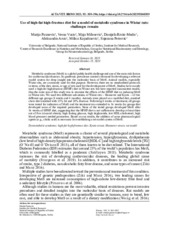Приказ основних података о документу
Use of high-fat high-fructose diet for a model of metabolic syndrome in Wistar rats: challenges remain
| dc.creator | Paunović, Marija | |
| dc.creator | Vučić, Vesna | |
| dc.creator | Milošević, Maja | |
| dc.creator | Ristić-Medić, Danijela | |
| dc.creator | Arsić, Aleksandra | |
| dc.creator | Kojadinović, Milica | |
| dc.creator | Petrović, Snježana | |
| dc.date.accessioned | 2024-01-27T11:09:53Z | |
| dc.date.available | 2024-01-27T11:09:53Z | |
| dc.date.issued | 2023 | |
| dc.identifier.issn | 0001-7213 | |
| dc.identifier.uri | http://rimi.imi.bg.ac.rs/handle/123456789/1417 | |
| dc.description.abstract | Metabolic syndrome (MetS) is a global public health challenge and one of the main risk factors for cardiovascular diseases. Its pandemic prevalence created a demand for developing a relevant model system for deep insight into the molecular basis of MetS. Animal models, especially Wistar rats, are commonly used for that purpose. However, there are no standardized protocols in terms of the diet, strain, or age of rats used for the development of MetS. Studies have mostly used a high-fat high-fructose (HFHF) diet in Wistar rats but have reported inconsistent results; thus the main aim of this study was to examine the effects of the HFHF diet on inducing MetS in Wistar rats. We used two different sub-strains of Wistar rats – Hannover and Kyoto – of two different age groups (8 weeks and 4 months). Animals were placed on a modified diet, standard chow diet enriched with 25% fat and 20% fructose. Following 8 weeks of treatment, all groups were tested for indicators of MetS and the treatment was extended to 16 weeks for groups that developed some of the required parameters. None of the tested groups developed MetS after 16 weeks of HFHF diet, suggesting that the HFHF diet is not sufficient to develop at least three out of five (visceral obesity, high fasting glucose, high triglyceride, low HDL-cholesterol, high blood pressure) needed parameters. Based on our results, the addition of some pharmacological agents (e.g., cholic acid) is necessary for establishing a rat model system of MetS. | |
| dc.publisher | University of Veterinary and Pharmaceutical Sciences | |
| dc.relation | info:eu-repo/grantAgreement/MESTD/inst-2020/200015/RS// | |
| dc.rights | openAccess | |
| dc.rights.uri | https://creativecommons.org/licenses/by/4.0/ | |
| dc.source | Acta Veterinaria Brno | |
| dc.subject | Dysmetabolic syndrome | |
| dc.subject | high-fat high-fructose diet | |
| dc.subject | Kyoto strain | |
| dc.subject | Hannover strain | |
| dc.subject | rat model | |
| dc.title | Use of high-fat high-fructose diet for a model of metabolic syndrome in Wistar rats: challenges remain | |
| dc.type | article | |
| dc.rights.license | BY | |
| dc.citation.epage | 396 | |
| dc.citation.issue | 4 | |
| dc.citation.spage | 389 | |
| dc.citation.volume | 92 | |
| dc.identifier.doi | 10.2754/avb202392040389 | |
| dc.identifier.fulltext | http://rimi.imi.bg.ac.rs/bitstream/id/3314/Use_of_high-fat_high-fructose_diet_for_a_model_pub_2023.pdf | |
| dc.type.version | publishedVersion |

